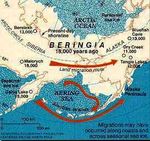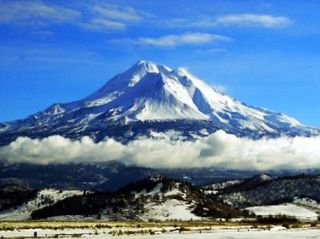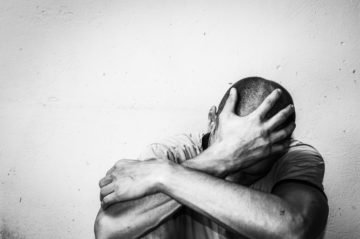by Akim Reinhardt
 There is scientific evidence indicating that Asiatic peoples migrated from Siberia to America many millennia ago via a land bridge that was submerged by the Bering Sea after the Ice Age ended, or by island hopping the Pacific cordillera in coastal water craft. But when I teach American Indian history, I don’t start the semester discussing Beringian crossing theory.
There is scientific evidence indicating that Asiatic peoples migrated from Siberia to America many millennia ago via a land bridge that was submerged by the Bering Sea after the Ice Age ended, or by island hopping the Pacific cordillera in coastal water craft. But when I teach American Indian history, I don’t start the semester discussing Beringian crossing theory.
Instead, I first talk about Indigenous creation stories. For example, a Jicarilla Apache story says that in the beginning, all the world was covered with water. Everything lived underwater, including people, animals, trees, and rocks, all of which could talk. People and animals used eagle feathers as torches, and they all wanted more light, except for the night animals who preferred the darkness: the panther, bear, and owl. The two sides competed by playing the thimble and button game. The sharp-eyed quail and magpie helped people win five consecutive games until the sun finally rose to create the first day. People then peered through a hole to see another world above them: Earth. They climbed up to it.
Or there’s a story from the Modocs of California and Oregon, which says the leader of the Sky Spirits grew tired of his home in Above World. It was always cold, so he carved a hole in the sky and shoveled down snow and ice until it almost reached the Earth, thereby creating W’lamswash (Mt. Shasta). He stepped from a cloud onto the mountain. As he descended, trees grew where ever his finger touched the ground, and the snow melted in his footsteps, creating rivers. Long pieces from his walking stick became beavers, and smaller pieces became fish. He blew on leaves, turning them into birds, and the big end of his stick created the other animals, including the bears, who walked upright on two legs. Pleased with what he’d done, the leader of the Sky Spirits and his family lived atop the mountain. But after his  daughter was blown down the mountain by the wind spirit, she was raised by a family of grizzly bears. When she became a woman, she married the eldest grizzly bear son, and their children were the first people. When the leader of the Sky Spirits found out, he was angry and cursed the bears, forcing them to walk on all fours ever since.1
daughter was blown down the mountain by the wind spirit, she was raised by a family of grizzly bears. When she became a woman, she married the eldest grizzly bear son, and their children were the first people. When the leader of the Sky Spirits found out, he was angry and cursed the bears, forcing them to walk on all fours ever since.1
One reason I begin the semester with Indigenous creation stories instead of scientific evidence about the peopling of the Americas is that, like most people who teach American Indian history nowadays, I look for ways to emphasize Indians’ historical agency. Stressing agency, the centrality of people in manifesting their own history, is an important part of teaching any group’s history. However, for too long, American Indian history was taught (when it was taught at all) through a EuroAmerican lense. Instead of looking at what Indians did, historians used to focus on what was done to them. Indians, they told us, were victims of aggression and/or obstacles to progress. Native people were reduced to two-dimensional tropes, mere foils in the larger story about European empires and the rise of the United States.
Read more »
 Sometimes our American ideas about social problems and how to fix them are downright medieval, ineffective, and harmful. And even when our methods are ineffective and harmful, we are likely to stick to them if there is some moralistic taint to the issue. We are the children of Puritans, those refugees who came to America in the 17th century to escape King Charles.
Sometimes our American ideas about social problems and how to fix them are downright medieval, ineffective, and harmful. And even when our methods are ineffective and harmful, we are likely to stick to them if there is some moralistic taint to the issue. We are the children of Puritans, those refugees who came to America in the 17th century to escape King Charles.